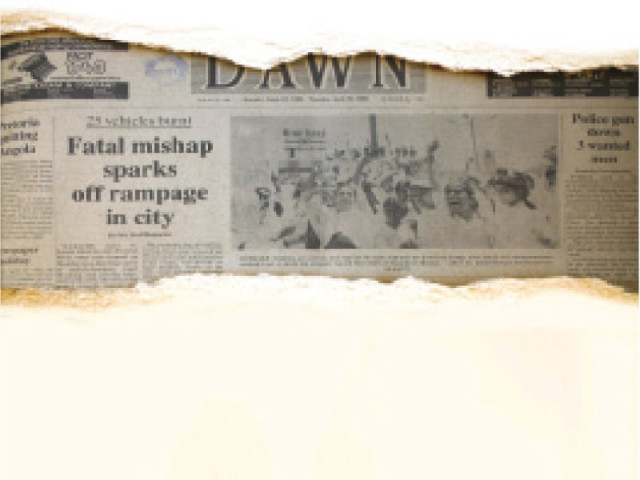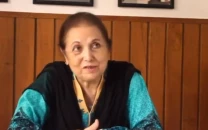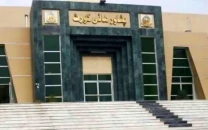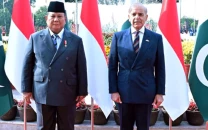March 8: Bushra Zaidi, the woman who changed Karachi forever, by dying
For international women’s day, we take a look back at the one name that stands out.

There is only one woman for Karachi.
Bushra Zaidi.
Her name launched a thousand protests and forever altered the city’s history. This is not to belittle the daily toil of our homemakers, nurses, architects, CEOs - women who contribute to Karachi just as much as any of its residents. But for International Women’s Day, we thought we would remember Bushra, the 20-year-old Sir Syed Girls College student, whose death in a traffic accident on April 15, 1985 was a turning point in the lives of everyone who has lived and will live in Karachi.
Twenty-seven years have passed, but Abdul Qayyum, who works as a clerk at the sports department at the college in Nazimabad, still has fresh memories of the day she died. “There were two N-1 minibuses racing and one of the bus drivers couldn’t apply the brakes in time,” he told The Express Tribune. Such is collective memory that many people believe that Bushra was killed while alighting from the bus and not as a result of being hit by one. Daily Dawn reported that the bus had knocked over a group of students, and three others were injured along with Najma.
According to Qayyum, Bushra and her sister Najma were crossing Nawab Siddiq Ali Khan Road at the time. Najma was badly injured – her leg was reportedly fractured - but Bushra was killed. Her body was taken to Abbasi Shaheed Hospital before the college staff arrived at the scene. They arranged a car for Najma to be taken to the hospital.
“The students of the Sir Syed Girls College tried to protest but [Professor Atiqa] Baig – the principal at the time – closed the college gates,” recalled Qayyum. “The girls forced their way out and were joined by female protesters from the nearby Usmania College and adjacent Government Degree College for Women, Nazimabad.” They gathered at Golimaar Chowrangi and boys from colleges in the vicinity also joined them. The boys toppled and then torched the bus.
The state responded. The police first lathi-charged the protesters and then unleashed an intense bout of teargas. The shells fell inside Sir Syed Girls College and even inside an ambulance. Dawn reported that four people were wounded by bullets and pellets, 80 were taken to hospital. It was so bad that the people living in Nazimabad had to keep buckets of water to counter the effects of the tear gas.
Students boycotted classes, put up barricades and pulled down hoardings. Dawn described scenes of total panic in Nazimabad and Liaquatabad, where the protests spread, and educational institutions were shut down for three days. The curfew was lifted for a few hours in select areas so people could buy food.
The ire of the protesters inevitably turned on the transporters. This sector was dominated by Pathans and this is what people have generally come to believe was the bus driver’s background. This has been cited in several books and research. Here too there is a discrepancy in the story and confusion. According to Ghous Ali Shah, who was the chief minister in 1985, the man who was caught and tried in a sessions court for his role in the accident, was originally from Azad Kashmir. And then, according to the president of Karachi Transport Ittehad, Irshad Hussain Shah Bukhari, the crime was committed by a Punjabi-speaking driver, who later spent 10 years in jail, and not a Pakhtun.
Nonetheless, Bushra’s death precipitated ethnic riots and violence. A week on, the toll reached 50 with 300 people injured, according to an account by the Associated Press (AP) news agency at the time. “Every ten minutes someone is being brought to the hospital with gunshot wounds,” AP was told by a local reporter for the second day of the riots.
Ghous Ali Shah ordered an investigation. The IG of police at the time was Agha Saadat Ali Shah, who is now dead. The investigating officer of the case, SSP Munawar Ali, died in 2006. Bushra Zaidi’s family, who had no political affiliation, are believed to have left the city and have not been heard from since the mid-1990s. Her father was reportedly working in Oman when his daughter was killed, and flew back.
Tahir Siddiqui, who owns a printing press in Nazimabad’s printing market, was approached by some boys who wanted a pamphlet to be prepared. He recalled how it contained inflammatory messages against Pathans and how it was later distributed in the Nazimabad area. No group was named on them.
Student leader Altaf Hussain had already created the All Pakistan Mohajir Students Organisation by then. Bushra’s death became a breaking point for a people who had already complained of not just the changes in the city, but also state discrimination. “For the first time, Karachi was high on the list of government priorities and things began to change,” recalled Dr Farooq Sattar of the Muttahida Qaumi Movement (MQM), while commenting on what Bushra’s case did for Karachi. For one, he told The Express Tribune, it led to a commission being set up in the late 1980s by then chief secretary Masooduz Zaman, who realised that there was a sense of deprivation and it needed to be corrected with the allocation of resources.
Subsequently, during Sattar’s tenure as mayor, 100 million gallons of water were added to the city’s supply. “Improving civic infrastructure, developing a mass transit programme, the water allocations... these were all as a result of the Bushra Zaidi accident,” Sattar said.
The MQM is not the only stakeholder that agrees with this. “It was the straw that broke the camel’s back,” said Munawwar Hasan, who now leads the Jamaat-e-Islami. “It was evident, but nobody could really see it [at the time].”
And thus, as we look back, nearly three decades on, we see that, in some ways, Bushra Zaidi is the only woman who matters for Karachi.
the IMAGE of the newspaper for
april 15, 1985 is COURTESY of DAWN ARCHIVES
DESIGN: MAHA HAIDER
Published in The Express Tribune, March 8th, 2012.



















COMMENTS
Comments are moderated and generally will be posted if they are on-topic and not abusive.
For more information, please see our Comments FAQ